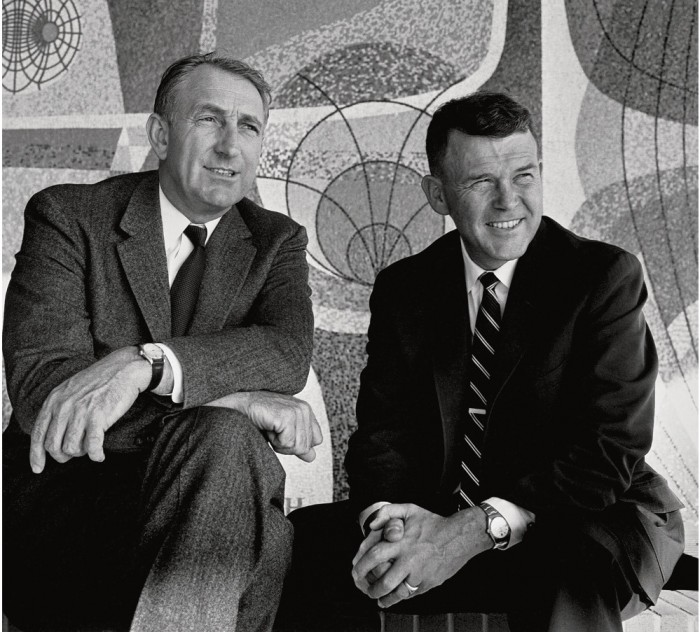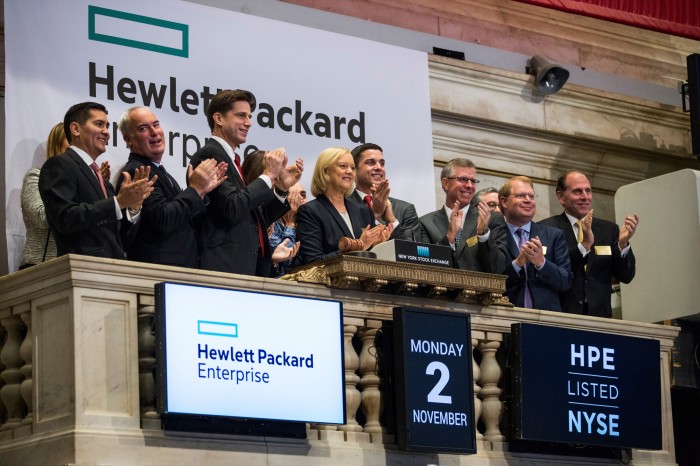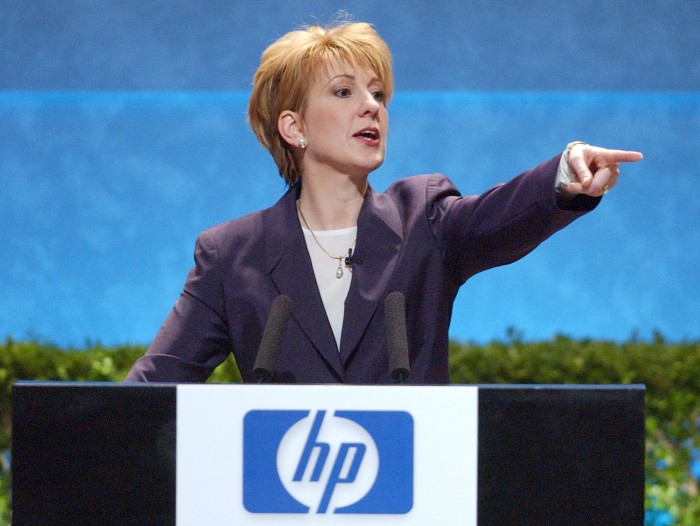Four Lessons for Silicon Valley from Its First Startup
In business as in life, nothing lasts forever—including the growth that high-tech juggernauts such as Amazon, Apple, Google, and Facebook have enjoyed in recent years. So when the growth inevitably slows, how can these companies manage the downshifting as adeptly as possible?
The history of Hewlett-Packard holds lessons. “HP has stayed relevant for nine decades,” says Webb McKinney, a former HP executive who has coauthored a new book called Becoming Hewlett Packard: Why Strategic Leadership Matters. “There has got to be inherent goodness in that.”
You’d be forgiven for having not thought about HP as an object lesson in management in recent years. Thanks in part to a string of unforced errors—ill-advised acquisitions, sex and spying scandals, a Keystone Cops board of directors—HP has been one of tech’s worst performers for the past 18 years. In 2015, CEO Meg Whitman finally gave up on trying to recapture HP’s past glory, and instead split the company in two. But before that, HP had a run of sustained growth that may never be matched. Even setting aside the first 20 years after Bill Hewlett and Dave Packard set up shop in a Palo Alto garage in 1938, the company grew by more than 20 percent a year for four decades, from 1958 to 1998.

Hewlett and Packard set the mold for the Silicon Valley startup. By employing management innovations—profit sharing, tuition assistance, cubicles, unlocked supplies closets—they created a company that melded their top-down visionary genius with a bottom-up culture that made the most of the technical talent that flocked to the company. Thanks to the so-called “HP Way”—a philosophy based on the belief that people want to do a good job, and will do so if upper management trusts them and gives them the tools they need to do their best—HP routinely dominated markets with innovative, reliable, fairly priced products. First came geeky engineering tools such as oscillators and signal generators, followed by handheld calculators in the 1970s, minicomputers in the 1980s, and then consumer products such as PCs and printers.
Today, HP’s model for success is woven into most technology companies to some degree. Even so, the reasons for its decline are less obvious. McKinney and consultant Philip E. Meza, who coauthored the book along with Stanford professor Robert A. Burgleman, cite four key ways the company could have pulled off a softer, less humiliating landing. They amount to four big lessons for Silicon Valley today.
Know when to shrink
Very few high-growth companies consider breaking themselves up when things are going well, even though doing so might give their individual businesses a better chance to prosper on their own. HP came tantalizingly close to avoiding this mistake back in 1999. After years of booming sales of PCs and printers to consumers and companies, sales of those products began to slow. With no new businesses on the horizon to take up the slack, CEO Lew Platt worried that HP had become too large and complex to manage. He commissioned a study that showed that HP and Walmart were the only companies that had passed $40 billion in annual revenue without hitting a painful “stall point” that required massive layoffs, management turmoil, and permanently slower growth. Platt hired consulting firm McKinsey & Co., which recommended three ways HP could break itself up into smaller, more agile parts.
HP’s board refused the recommendation for many of the wrong reasons, says McKinney. Directors, including four members of Hewlett’s and Packard’s families, feared a loss of prestige. The tricky tax complications from a potential split provided “a great excuse not to do anything,” says Mike Neven, the McKinsey consultant who led the project. Instead, the board spun off the original test and measurement division, which accounted for 10 percent of revenue, into a company called Agilent Technologies—and replaced Platt with Carly Fiorina, who decided in 2001 to double down on scale by acquiring PC giant Compaq Computer. (Among other jobs, McKinney co-managed the integration of HP and Compaq for Fiorina.) Had HP’s consumer businesses been spun off in 1999 rather than in 2014, it might have targeted the booming smartphone market—something Fiorina didn’t want to do for fear of upsetting big phone companies that bought a lot of HP’s back-office IT equipment.

Will today’s high-fliers get it right? Google’s decision to reorganize as Alphabet shows it is thinking about the problem. By separating its gold-mine search business, nascent efforts to build businesses in biotech, Internet access, and other areas can get the focus they need. Neven thinks the time will come when Amazon will split off its fast-growing AWS cloud services business from its namesake online store, in part to help it win business from Amazon’s growing list of rivals as it expands beyond e-commerce into areas such as entertainment and grocery delivery. Apple faces a particularly intractable problem, given how tightly linked all of its products are. It’s not clear what Apple could sell off, or how it can compensate for softening sales of the iPhone, which brings in nearly two-thirds of the company’s sales. “Every company gets to the point that sales of old products go down faster than you can come up with new ideas,” says former HP CEO John Young, who oversaw HP’s long, difficult march into the computer business in the 1970s and 1980s. “The wall in front of Apple looks really steep to me.”
Don’t let the board of directors get stale
For all of their management genius, Hewlett and Packard ran a decidedly rubber stamp board, staffed mostly with old friends such as Nobel Prize winning physicist Luis Alvarez. That was fine so long as the company stayed within its wheelhouse in engineering equipment, but it created a void as HP got into computers, printers, and other fast-emerging businesses. When HP started to hit the skids in the late 1990s, there was no one on the board to help the CEO position HP for success in massive emerging opportunities such as smartphones and cloud computing, says co-author Meza. The brass did mull whether to change the carpet in Bill and Dave’s old office, however.
Today’s companies are stacked with tech-savvy executives and venture capitalists, but they need to do a better job of bringing in new blood, given the rate at which these companies are moving into new industries—say, health care or cars. (There are exceptions. Facebook added former Genentech executive Susan Desmond-Hellmann in 2013, and Google added former Ford CEO Alan Mulally in 2014.) Facebook, currently under fire for the role fake news played on its platform during the presidential campaign, does not have a publishing executive on its board. Boards are also under fire to increase the gender and racial diversity of their boards, but diversity of industrial experience will matter as well.
Make sure “culture” is about values, not practices
HP’s founders created what became known as the HP Way in several ways. Examples include insisting that the company enter markets only where it could make a meaningful contribution of valuable technology; asking employees to take pay cuts in tough times to avoid layoffs; and fostering understanding and collaboration between all corners of the company. “Management by walking around,” they called it. But as the years passed, many employees came to equate the HP Way with particular traditions, such as the daily doughnut breaks meant to encourage conversation, or the right of top performers to earn full product-and-loss authority over their own product groups. That last one became a huge problem for Young, because building computer platforms requires development of hardware, software, and other technologies that are all interdependent.
The future leaders of today’s tech giants should be prepared for similar grumbling if they have gotten too many employees accustomed to such perks as on-site massages, laundry service, and climbing walls. (Dropbox said in a filing this year that it spent $25,000 in perks on every employee.)
Groom successors—then groom more

For decades, HP was famed as a talent factory. It cranked out dozens of executives who went on to run other important companies. But as the business grew and became more complex, the company didn’t do enough to keep a stable of executives capable of becoming the next CEO. After requesting Platt’s departure, the board went outside in part because all of the internal candidates only had experience running their corner of the business. Instead, they hired Fiorina, a marketing and sales whiz who had never been a CEO or even run a large P&<. When she was fired in 2005, after repeatedly refusing the board’s request that she name a chief operating officer to help run the company, the board opted for another outsider in Mark Hurd. The internal talent problem had not been addressed when Hurd was pushed out five years later, setting off the short, unsuccessful tenure of German software executive Leo Apotheker.
Apple, in contrast, made a seamless transition to Tim Cook after Steve Jobs’s death in 2011. As interim CEO during Jobs’s illnesses, it was clear he was the heir apparent. Yet most Apple-watchers said Cook was the only real choice. And with the exception of a few superstars such as Facebook’s Sheryl Sandberg and Google chief Sundar Pichai, few executives are getting the breadth of experience—both in the types of businesses they can run, and in the range of corporate functions—to be shoo-in candidates to run these huge companies. Making matters worse, many talented executives are no longer waiting around to climb the corporate ladder and often leave to try their own hand at company-building. So who knows who will be available to move up when Larry Page, Jeff Bezos, or Mark Zuckerberg decide to move on?
Peter Burrows is a tech journalist who covered HP for many years and wrote Backfire: Carly Fiorina's High-Stakes Battle for the Soul of Hewlett-Packard. He was one of the reporters spied on by HP in 2005.
Keep Reading
Most Popular
Large language models can do jaw-dropping things. But nobody knows exactly why.
And that's a problem. Figuring it out is one of the biggest scientific puzzles of our time and a crucial step towards controlling more powerful future models.
How scientists traced a mysterious covid case back to six toilets
When wastewater surveillance turns into a hunt for a single infected individual, the ethics get tricky.
The problem with plug-in hybrids? Their drivers.
Plug-in hybrids are often sold as a transition to EVs, but new data from Europe shows we’re still underestimating the emissions they produce.
Stay connected
Get the latest updates from
MIT Technology Review
Discover special offers, top stories, upcoming events, and more.